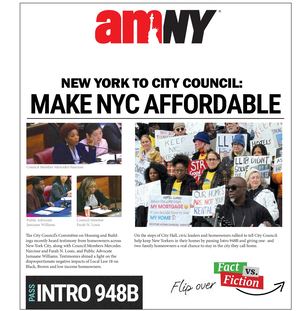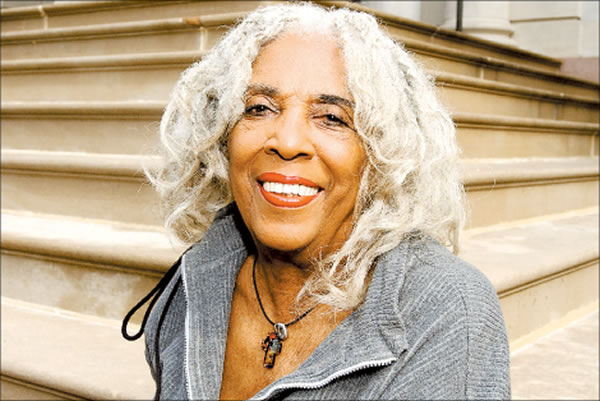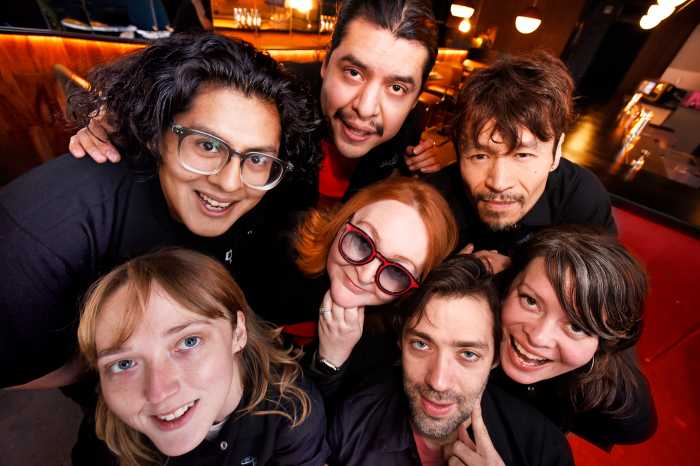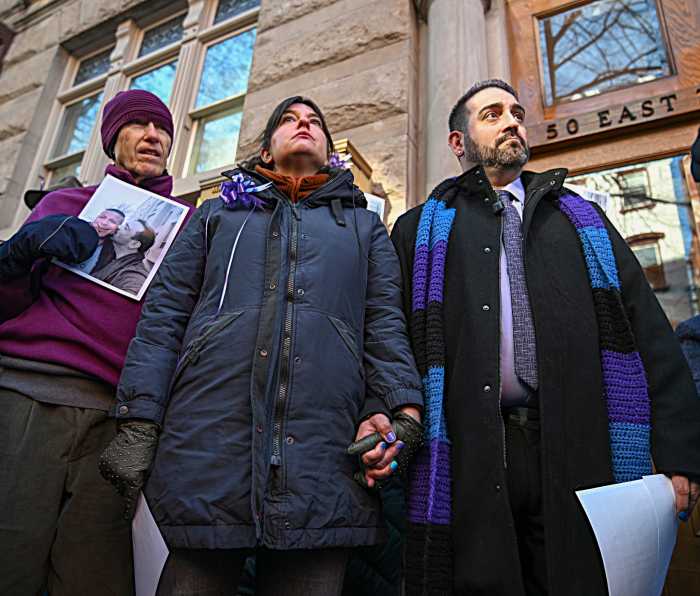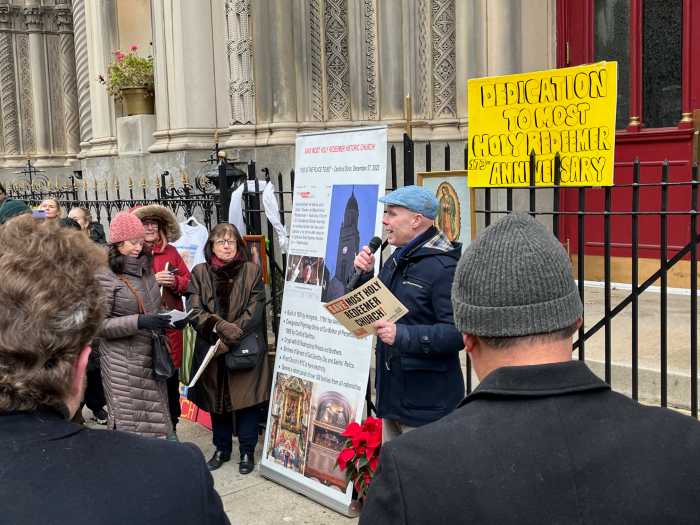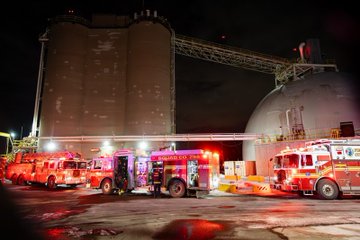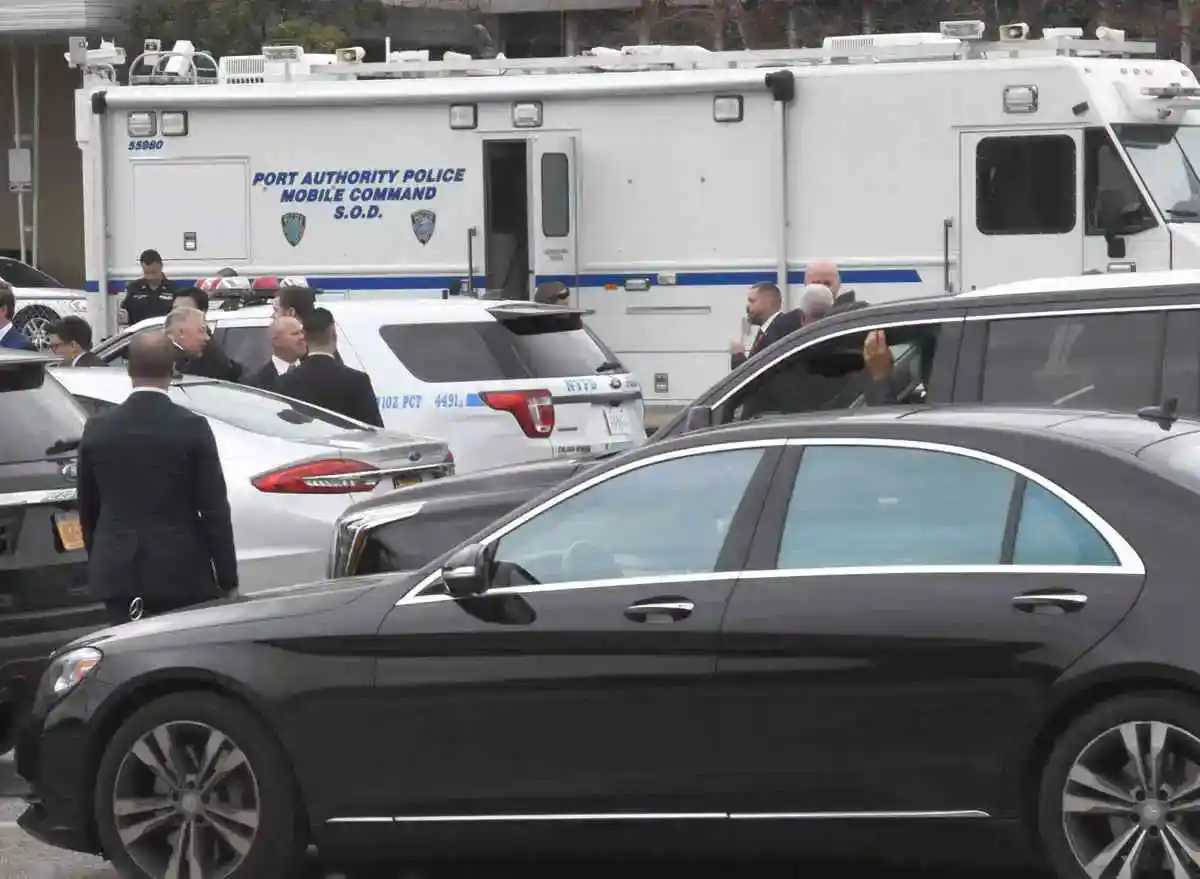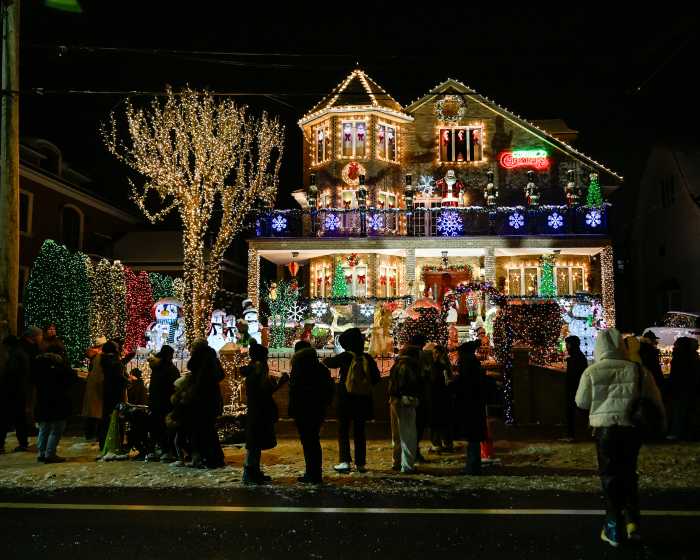By JERRY TALLMER
Volume 80, Number 34 | January 20 – 26, 2011
West and East Village, Chelsea, Soho, Noho, Little Italy, Chinatown and Lower East Side, Since 1933 File photo
Ellen Stewart, founder of La MaMa Theatre, was at City Hall in September 2004 for the announcement of the Fourth Arts Block deal with the city. Seven properties on E. Fourth St. between Bowery and Second Ave., plus several vacant lots, were sold for $1 each to Fourth Arts Block, a.k.a. FAB. Under the deal, the properties were permanently dedicated for use by cultural, nonprofit organizations, assuring that the theaters, dance studios and other artistic uses on the block would not disappear. It must be at least 30 years ago that I went to visit Ellen Stewart at N.Y.U. Hospital. She was all dolled up in bed in a fancy pink and yellow ruffled nightgown. “Hello, honey,” she said in that wonderful, inimitable, sharp-edged, soft-core Geechee English that now none of us will ever hear again. “I died twice since you saw me last.” Well, three strikes is out — or maybe 53 strikes of terminating illness, all told, since then. Ellen Stewart, the creator and lifelong prime mover of Off Off Broadway’s world-embracing La MaMa E.T.C. (Experimental Theatre Club), departed this earth late Wednesday night or early Thursday morning, January 13, 2011. She may have been 91. She may have been more. Ellen wasn’t going to tell you. The New York Times gives her birth date as November 7, 1919, her place of birth as Chicago, her place of death as Beth Israel Hospital in this city, and says she “spent her childhood years” between Chicago and the rather smaller Alexandria, Louisiana, though I always thought it was the other way round, Louisiana first — Geechee terrain — then Chicago. It was all a sort of mystery, an unwritten — never-to-be-written — Faulkner novel. But once — just once — when she was letting drop a little bit about her days in Chicago before coming to New York, she hit me with a sunny little s–t-eating Shirley Temple smile, and then: “Some people used to think me pretty, you know.” Pretty? As my mother would have said, Cleopatra isn’t in it. Sheer café-au-lait gorgeous is what Ellen was, and ever more so as the years went by and the fragility burned ever brighter. Fragile — but oh my! Henry James would have had a field day word-painting it for us, Ellen Stewart’s ever- increasing incandescence. This farewell is being written several days before a Mass for Ellen was to be held Monday morning January 17, at St. Patrick’s Cathedral, Fifth Avenue and 50th Street — a most appropriate locale in the light of what Ellen, in a profile by me in Thrive, had recalled a few years ago about her arrival in New York in 1950 as an unknown would-be fashion designer. A cab driver had charged her 50 bucks to take her from Grand Central Station to the Hotel Theresa in Harlem, but Fidel Castro, as it happens, had taken over the whole Hotel Theresa. Somehow she found another hotel. “Monday morning the man on the elevator told me I could ride all the way downtown on a bus. Went downtown, looking for a job, didn’t get it, saw this big church across the street from a big store. Went into the church, which was St. Patrick’s Cathedral, said a prayer, came out and went into the store, which was Saks Fifth Avenue. I didn’t know what Saks Fifth Avenue was.” She soon learned. This was in the days when Negro employees at such big emporia were called “coloreds” and, at Saks, were required to wear blue smocks.
“Sophie Gimbel, who owned the store, said: ‘No niggers in my department’ — yes,” Ellen had declared, “she really said that.” But in the face of such open bigotry at the top and the envy verging on hatred by many at the bottom, black as well as white, black even more than white, slim, stunning “Miss Ellen” did become one of Saks Fifth Avenue’s top dress designers of that era. And not in a blue smock. Cut to a cold night on MacDougal Street in the early 1960’s. It is intermission time at some play or other, and Ellen Stewart, somebody I barely then know, is chatting on the sidewalk with a tall, skinny, coatless, not-bad-looking young guy who is hugging himself for warmth as he hops up and down on one foot and the other. “This is one of my chicks,” she says to me with a laugh. “His name is Sam Shepard.”
It was to provide a nest for all her chicks that Ellen Stewart had in 1962 opened a tiny Off Off Off coffeehouse theater in a $50-a-month basement at 321 East Ninth Street, mostly for the benefit of two fledgling playwrights, Paul Foster and Fredrick Lights (the foster brother who’d lived across the hall from her in Chicago). The first plays ever done on Ninth Street were Leonard Melfi’s “Lazy Baby Susan,” Michael Locascio’s “A Corner of the Morning” and Andy Milligan’s adaptation of the spooky Tennessee Williams short story “One Arm.” Even though the audiences usually ran to no more than 10 or a dozen hardy souls, Ellen had to shake a miniature cowbell and quiet them down at the start of every show with the mantra: “This is La MaMa E.T.C., dedicated to the playwright and all aspects of the theater.” I still have one of those bells.
Harvey Fierstein’s much-quoted “Eighty percent of what is now considered American theater originated at La MaMa” may not be altogether true, but it is true enough. Nobody knows just how many thousands of playwrights, composers, directors, designers, techies and, oh yes, actors, have been hatched at La MaMa over the past half century, or how many countries around the globe have in one way or another been enriched by La MaMa and vice versa. (The next thing I have to write about in these pages is an angry new play coming to La MaMa from Estonia.) But Ellen was pursued by bigotry even unto 321 East Ninth Street, a building dedicated to, in Ellen’s words, “no Jews, no Hispanics, no niggers.” The word was spread around the block that she was running a whorehouse. Finally, to save her landlord from having his property wrecked, La MaMa moved out, in the middle of the night, to 82 Second Avenue, and subsequently to a larger space one flight up over a dry cleaner’s at 122 Second Avenue. It was there that I caught up with La MaMa E.T.C. and the wielder of that cowbell.
Her troubles were not over. It was a time when Ed Koch, the mayor, and Robert Moses, the commissioner of everything, were cleaning up the Village and East Village.
“They cleaned up on us,” Ellen had dryly remarked during that profile interview, but in the end, La MaMa outlasted and outmaneuvered them by obtaining an impossible-to-obtain coffeehouse license. A couple of other hops along St. Mark’s Place finally led to 74-A East Fourth Street, thanks to a $25,000 Ford Foundation grant arranged by a good man named McNeil Lowry. Most of the $25,000 went toward installing a whole new roof and rear wall, but 74-A East Fourth Street remains La MaMa’s home base from that day to this. Oh yes, Ellen had her faults, as who does not? To her, theater was movement and feeling before all else; she had all too little respect for the written and printed word. You never found much Shakespeare going on at La MaMa; she left that to Joe Papp. But you could always find a superfluity of those Old Greeks and their wailing Trojan Women. Plus everything else. If Ellen was totally loving she could also be very angry, and could maintain that anger a long time, as she did with me after an Israeli actress/director I’d befriended turned out to have used a La MaMa booking to lie her way through Immigration. I rather think Ellen increasingly liked being treated, toward the end, as a princess — no, loved it. But again, who would not?
There’s an incident I wrote about some years ago, and now I’m never going to have the opportunity to write about it again, so here goes:
In the winter of 1998 there was an exhibit at Cooper Union of posters of La MaMa productions from here, there, everywhere around the world. I had the bright idea of walking through the gallery with Ellen while she told me about this place, that place, this audience, that audience, whatever… . She said: “Fine, I’ll meet you at the exhibit.” But then her son Larry Hovell, out in Green Bay, Wisconsin, was about to die, and she had to go be with him. He took a turn for the better, she returned to New York, we made a second date to go through the exhibit; then Larry really did die. Now, upon her return, we made a third date to view those posters, this time on the Saturday afternoon before a Broadway show I had to cover. When I got to Cooper Union at the appointed hour, no Ellen in sight, but a La MaMa aide was there to apologize and tell me Ellen was ill.
What kind of ill?
“She’s sitting on that wooden bench just inside the front door. She’s shivering all over. She can’t talk.”
Cooper Union is only two blocks from La MaMa. I covered the ground as fast as I could. Sure enough, Ellen was sitting, all huddled up, on that small wooden bench just to the left of La MaMa’s front door. She was shivering uncontrollably. I sat down, put my arm around her, and suggested we go to a hospital. She shook her head, No. We sat like that for a long time, and she never stopped shivering. Of course there was no way to get her to her apartment, five flights of stairs over where we were sitting. Finally, I said: “Look, I’ll cancel the thing I have to see tonight.”
“No,” Ellen said — found the strength to say — “You go do your job. I’ll be all right.”
So I went.
Before the uptown show I called La MaMa. The woman in the La MaMa box office said Ellen was still sitting there, still shivering, just a few feet away. No, Ellen couldn’t physically get to her feet. At intermission I phoned again. Same story. And at close to midnight I called once more. Nothing had changed.
Around 10 a.m. Sunday I called La MaMa anew. Was Ellen Stewart still there on that bench? Could she now get to the phone?
“Oh no,” said the box-office person, “Ellen’s over in the Annex, moving the furniture around.”
Dear Old Greeks and Trojan Ladies up there, please lend Ellen Stewart a hand with those chairs.
Ellen: The Mama of them all
